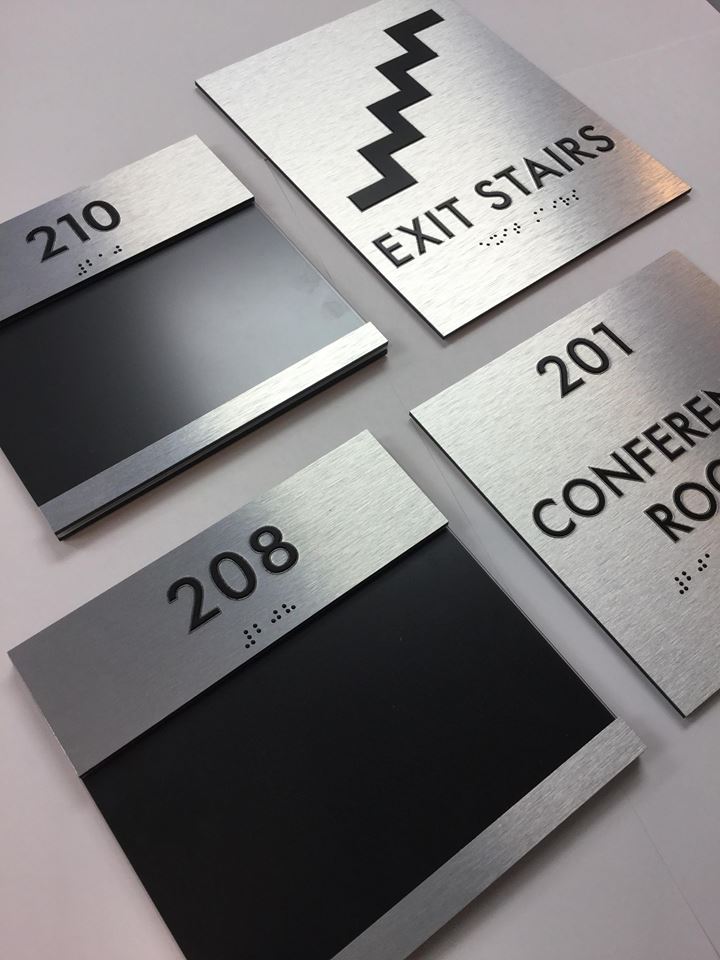Discovering the Trick Functions of ADA Indicators for Boosted Availability
In the world of availability, ADA indicators serve as quiet yet powerful allies, making sure that spaces are inclusive and accessible for individuals with specials needs. By incorporating Braille and tactile components, these signs break obstacles for the visually impaired, while high-contrast shade schemes and readable typefaces cater to varied visual demands.
Significance of ADA Conformity
Making sure conformity with the Americans with Disabilities Act (ADA) is critical for fostering inclusivity and equivalent accessibility in public spaces and offices. The ADA, enacted in 1990, mandates that all public centers, employers, and transportation services suit people with specials needs, ensuring they take pleasure in the exact same civil liberties and opportunities as others. Compliance with ADA standards not only satisfies lawful commitments but also enhances an organization's track record by showing its commitment to diversity and inclusivity.
One of the essential aspects of ADA conformity is the execution of easily accessible signage. ADA signs are made to make sure that individuals with disabilities can conveniently navigate through structures and areas.
Additionally, adhering to ADA regulations can minimize the danger of legal effects and prospective fines. Organizations that fall short to adhere to ADA standards may encounter charges or lawsuits, which can be both harmful and monetarily troublesome to their public photo. Therefore, ADA conformity is essential to cultivating an equitable setting for everyone.
Braille and Tactile Components
The incorporation of Braille and responsive elements right into ADA signage personifies the concepts of accessibility and inclusivity. These attributes are important for people who are blind or visually damaged, enabling them to browse public rooms with greater self-reliance and self-confidence. Braille, a tactile writing system, is vital in giving written info in a layout that can be easily perceived with touch. It is typically put underneath the corresponding text on signage to make sure that individuals can access the information without visual help.
Tactile elements extend past Braille and consist of elevated personalities and icons. These elements are created to be discernible by touch, allowing individuals to recognize area numbers, bathrooms, departures, and other crucial locations. The ADA establishes certain guidelines regarding the dimension, spacing, and positioning of these tactile elements to maximize readability and make certain uniformity across different settings.

High-Contrast Color Pattern
High-contrast color design play a crucial function in enhancing the presence and readability of ADA signage for individuals with aesthetic disabilities. These plans are necessary as they make the most of the difference in light reflectance between message and history, guaranteeing that indications are easily noticeable, also from a range. The Americans with Disabilities Act (ADA) mandates the usage of details shade contrasts to fit those with limited vision, making it a vital facet of conformity.
The effectiveness of high-contrast shades depends on their capacity to stand out in different lighting conditions, consisting of dimly lit atmospheres and locations with glare. Generally, dark message on a light background or light text on a dark history is employed to accomplish optimum contrast. For circumstances, black message on a white or yellow history provides a plain aesthetic difference that aids in quick recognition and comprehension.

Legible Fonts and Text Size
When taking into consideration the style of ADA signs, the selection of clear font styles and proper message dimension can not be overemphasized. These elements are essential for making view it now sure that indicators are accessible to individuals with visual impairments. The Americans with Disabilities Act (ADA) mandates that font styles need to be not italic and sans-serif, oblique, script, highly ornamental, or of uncommon type. These demands assist make certain that the message is conveniently legible from a range which the personalities are distinct to varied target markets.
According to ADA guidelines, the minimum text elevation ought to be 5/8 inch, and it ought to enhance proportionally with viewing range. Consistency in message size adds to a cohesive aesthetic experience, helping people in navigating settings effectively.
Furthermore, spacing in between letters and lines is integral to clarity. Adequate spacing protects against characters from showing up crowded, enhancing readability. By sticking to these standards, designers can considerably improve accessibility, making certain that signage offers its desired purpose for all people, no matter their aesthetic capabilities.
Efficient Placement Approaches
Strategic placement of ADA signs is vital for optimizing access and ensuring conformity with lawful requirements. ADA standards state that signs should be mounted at an elevation in between 48 to 60 inches from the ground to guarantee they are within the line of view for both standing and seated individuals.
Furthermore, signs must be placed adjacent to the lock side of doors to enable simple identification prior to entrance. This positioning assists individuals situate spaces and spaces without blockage. In instances where there is no door, indicators ought to be situated on the local nearby wall. Uniformity in indication positioning throughout a center enhances predictability, decreasing complication and enhancing overall customer experience.

Verdict
ADA indications play an essential role in promoting access by integrating functions that resolve the needs of individuals with handicaps. Incorporating Braille and tactile aspects makes certain vital details is accessible to the visually impaired, while high-contrast shade systems and legible sans-serif fonts improve exposure throughout numerous illumination problems. Reliable positioning strategies, such as ideal mounting elevations and strategic places, even more assist in navigating. These components jointly cultivate a comprehensive setting, emphasizing the importance of ADA conformity in ensuring equal access for all.
In the world of availability, ADA indicators offer as quiet yet effective allies, making sure that areas are navigable and inclusive for individuals with handicaps. The ADA, enacted in 1990, mandates that all public facilities, companies, and transport services accommodate people with handicaps, guaranteeing they take pleasure in the very same legal rights and chances as others. ADA Signs. ADA indications are designed to make sure that individuals with specials needs can quickly navigate with read the full info here buildings and rooms. ADA standards state that signs need to be installed at an elevation between 48 to 60 click for info inches from the ground to guarantee they are within the line of sight for both standing and seated people.ADA indications play an important duty in promoting access by integrating features that attend to the needs of people with impairments
Comments on “The Duty of ADA Signs in Following Accessibility Criteria”